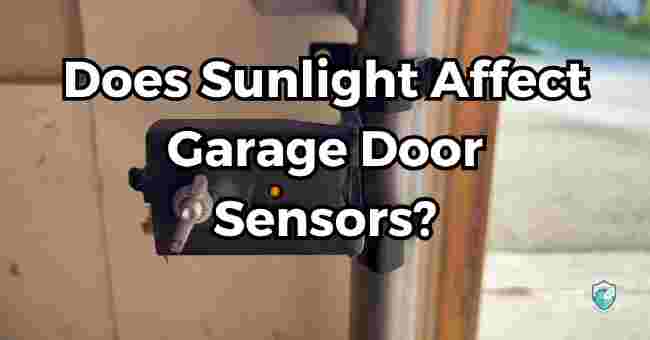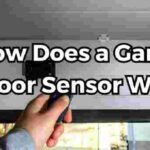Table of Contents
Does sunlight affect garage door sensors? Absolutely, and often in disruptive, problematic ways.
I firsthand experienced the chaos that can ensue when my home garage sensor system started malfunctioning inexplicably.
My door would randomly reverse open while trying to shut it, or just get stuck in limbo not opening or closing properly.
After troubleshooting every possibility, I finally realized the issues only cropped up at certain times of day when sunlight perfectly angled into the garage and flooded my sensors.
Once I figured out the solar interference and added visors above the sensors to block direct light, the problems disappeared.
Clearly sunlight can wreak havoc with the infrared systems in those innocuous little safety scanners, as I’ll explain.
Overview
As garages have evolved from simple storage sheds to fully outfitted multipurpose rooms and workshop spaces, the garage door has become an integral access point in many homes.
Those garage doors are typically outfitted with automated openers and safety sensors to provide convenience and security.
But if you’ve ever had your garage door sensors malfunction or stop working properly seemingly at random, sunlight interfering with the sensors might be the culprit.
In this complete guide, we’ll cover how sunlight causes issues with garage door sensors, what specific problems it can create, solutions to prevent and fix sunlight interference problems, and when it’s best to call in a pro for assistance.
Let’s shine some light on the issue of solar disruption for your essential garage door safety sensors.
How Does Sunlight Affect Garage Door Sensors
To understand how and why sunlight can wreak havoc for your garage door sensors, you first need to comprehend what makes those sensors work in normal conditions.
Garage door sensors, sometimes referred to as photo eyes, operate by sending out infrared light beams between the two sensor units positioned on either side of the door.
When something blocks that invisible light beam as the door closes – like a car, pet or person – the sensor signals the opener to immediately halt and reverse the door to open again.
- The issue arises because sunlight carries infrared light, just like the safety sensors rely on. So beams of sunlight can confuse the sensors.
- Direct sunlight exposure pouring straight onto one or both sensors can entirely disrupt the infrared systems, essentially blinding the photo eyes.
- But even just ambient sunlight in the general vicinity can interfere with garage door sensors and cause operational problems.
Let’s examine some of the common interference issues that can arise specifically when sunlight and garage door safety sensors meet.
Infrared Light Confusion
The infrared light from direct sun beams or ambient solar glare can entirely overwhelm sensors that are trying to send out or receive very controlled infrared signals between one another.
This can lead to the receiving sensor being unable to correctly detect that steady stream of infrared light.
Direct Sunlight Exposure Issues
If one or both of your garage door photo eyes are positioned in areas that receive direct sunlight at certain times of day, the solar infrared waves can compete with and overtake the sensors’ infrared transmissions.
The sunshine essentially blinds the system. This direct interference with sunlight can cause all sorts of problems.
Garage Door Problems Caused by Sunlight
When sunlight disrupts your garage door sensors, whether from direct exposure or ambient interference, a number of issues can crop up in the functionality and operation of your garage door opener system.
Here are some of the most common problems homeowners experience due to sunlight problems with their safety sensors:
Sensors Not Responding
If one or both of your photo eyes are getting direct blasts of sunshine during certain times of the day, the sunlight can entirely overwhelm the sensor system. The sensors may struggle to send or receive their infrared signals back and forth.
You might notice this manifesting in your garage opener system acting finicky, stalling out or reversing back open at random times rather than closing smoothly.
Checking your sensors when these issues arise and noticing direct sun shining on them could signal sunlight is to blame.
Door Not Closing
If your garage door opens fine, but refuses to close or reverses back open at the same spot every time you try to shut it, sunlight confusing the sensors is very likely the culprit.
The sunlight overwhelms the system so the sensors can’t properly aligned and think something is blocking the door.
False Sensor Triggers
Another common symptom of solar interference with garage door sensors is random triggering when nothing is obstructing the door.
The sunlight confuses the system into thinking something is blocking the door, causing the opener mechanism to stop and reverse open again unnecessarily.
If you’ve experienced phantom triggering of the safety sensors for no apparent reason, inconsistent sensor functionality, or problems with getting your system to properly align and calibrate, sunlight could very well be the issue.
Now let’s explore solutions for preventing and addressing sunlight problems with your critical garage door sensors.
Solutions for Sunlight Interference
Thankfully there are a number of effective solutions you can implement to prevent sunlight from disrupting your garage door sensors or resolve existing solar interference issues:
Adjust Sensor Angles
Often the easiest solution is simply angling the sensors slightly to avoid direct sunlight exposure.
Aiming the sensors even a few degrees to the side so they sit in shade can make a major difference.
Use Sun Shades or Awnings
If adjusting the aim alone isn’t enough, adding above the sensors a simple awning, sun shade or visor can help block direct sunlight.
This prevents solar infrared light from overwhelming the photo eye system.
Upgrade to Advanced Sensors
Some modern garage door sensor models feature interference avoidance technology, like LiftMaster’s Sure-Lock sensors, specifically designed to prevent sunlight confusion.
Upgrading to these advanced sensors can solve recurrent solar disruption issues.
Reset and Realign Sensors
Sometimes seemingly spot-on aligned sensors can still get confused by sunlight flooding the receivers.
Resetting then realigning the eyes per the opener manufacturer’s instructions can overcome minor solar interference.
Test Sensors Periodically
One smart preventative step is periodically testing your garage door sensors sensitivity by blocking the beams with various objects, ensuring the opener immediately stops and reverses when the photo eye path gets crossed at any point.
Catching minor sunlight issues before they become major is sensible prevention.
As you can see, solutions for dealing with the sunlight factor on garage door safety sensors range from small adjustments and upgrades to improving preventative maintenance.
Now let’s go over some proactive steps you can take to avoid sunlight issues cropping up in the first place.
Preventing Future Sunlight Problems
Completely eliminating potential sunlight interference with garage door sensors isn’t always possible. But you can take key steps to minimize the risks:
Install in Shady Location
- When first installing new garage door sensors, survey sunlight patterns on the garage and door so that you can position the photo eyes in permanently shaded spots that will never receive direct sunlight exposure.
Choose Sensors With Sun Protection
- Select advanced safety sensor options like Chamberlain’s Sure-Lock or LiftMaster’s Premium Multi-Function model that come equipped with sunlight rejection technology.
Test Sensors Periodically
- Get in the habit of routinely validating the alignment and responsiveness of your garage door sensors. Catch minor solar disruption before it becomes a major nuisance.
Making sunlight interference avoidance a priority when selecting, installing and maintaining your garage door’s safety sensors pays dividends by preventing annoying operational issues.
When You Need a Pro for Sunlight Sensor Issues
While minor solar disruption of garage door sensors can often be addressed with shade adjustments and realignment, more complex interference issues may require bringing in a professional:
- If your DIY efforts just can’t seem to solve recurrent sunlight-related sensor problems, a pro garage door technician has specialized equipment and expertise to remedy issues and improve sunlight immunity with adjustments and upgrades.
Reach out to a reputable local pro like DFW Garage Door for personalized solutions. - For older openers with aging sensors that battle frequent solar interference despite your best efforts, a full replacement with modern sunlight-resistant hardware may be warranted.
Pros like Overhead Door Company of Punta Gorda can expertly install compatible new openers and sensors. - Tricky garage or sensor positioning that fights solutions may call for a pro’s touch. Precision installation aligned just right while avoiding sunlight can overcome sensitivity. Techs from companies like Platinum Garage Door Service specialize in expert alignment.
Don’t let your garage door safety sensors sunlight problems persist! Take control with solutions and prevention.
And leverage professional services when needed to keep your system running smoothly.
Determining If It’s a Sunlight Problem
Spotting the signs of solar interference versus other sensor disruptions takes a careful eye and process of elimination.
- Start by checking if other electronic garage door openers or devices work normally while the sensors face issues. If it’s only the sensors malfunctioning, sunshine disruption is a prime suspect.
- Also take note if the sensor functionality frustrations happen at consistent times of day that correlate with sunlight shining on their locations at that time.
- And try temporarily moving the sensors entirely into shade as a test when troubles arise. If that immediately restores normal operation, sunlight is undoubtedly the culprit.
By watching closely and running tests during episodes of sensor failure, you can confirm solar interference.
FAQs
Why Is My Garage Sensor Not Working In The Sun?
Sunlight contains infrared waves just like what garage door sensors rely on to communicate.
Direct hits from sunshine or even ambient light overwhelm and disrupt the sensors’ infrared systems.
This leads to operational failures, phantom obstruction signals, doors reversing open unexpectedly, and other issues.
Essentially the sunlight “blinds” the sensors. Make sure your sensors are angled to avoid direct sunlight. Relocating them to shaded areas can also help restore normal function.
How Do You Shade Garage Door Sensors?
To shade your garage door sensors from sunlight:
- Install a small awning or sun visor above the sensors, positioned to block direct sun exposure at problem times
- You can buy commercial photo eye shades, or create DIY shades from materials like cardboard covered in reflective tape
- Add exterior hang-down shades or plant taller vegetation if no overhang exists
- Aim the sensors to face east/west instead of southerly directions prone to sunlight
- Or angle the sensors slightly inward or outward so sun misses them
Proper shading prevents sunlight from disrupting the sensors’ infrared communication system.
How Do I Protect My Garage Door From The Sun?
To protect the entire garage door itself from sun damage:
- Apply a UV-resistant sealant made for exterior wood and metal
- Maintain the factory-applied coating; repaint when faded
- Install a solar screen roller shade above the door to block sunlight
- Consider replacing with a door containing insulation to prevent heat transmission
- Plant trees, bushes or vines to provide shade naturally
- Build an extended roof overhang across the front of the garage
Shielding your garage door from intense sunlight extends its longevity and functionality.
Does Heat Affect Garage Door Sensors?
Yes, excessive heat can potentially affect the functioning of garage door sensors. Most sensors operate properly in climates ranging from -40°F to +160°F.
But in extreme heat, the internal components can sustain damage, causing inaccurate readings or failures.
To protect your sensors from heat impacts:
- Shade the sensors from direct sun whenever possible
- Improve ventilation and airflow around the sensors
- Consider fans or cooling systems in hot climates
- Upgrade to industrial-grade sensors designed for hot temps
Keeping sensors away from heat extremes ensures longevity and safety.
Can Sunlight Set Off Motion Sensor?
Yes, sunlight striking a motion sensor lens directly can mimic temperature changes that would occur from a passing person or animal.
This false trigger confuses many motion detectors into activating. Avoid pointing sensors at areas of sunlight movement.
Outdoor motion sensors should also have “sunlight rejection” tech to minimize this risk.
Can You Make A Garage Door Work Without Sensors?
It is not advisable to make your automated garage door function without working safety sensors.
These sensors are vital to prevent serious injury or death if someone or something gets trapped under the closing door. Removing sensors disables this essential safety reversal system.
However, if the wires are damaged, aligning emitter & receiver properly can allow manual open/close while repairs are completed.
Only attempt manually operating doors without sensors extremely cautiously and for very short durations.
How Do I Know If My Garage Door Sensors Are Misaligned?
Signs your garage door sensors are misaligned include:
- Door automatically reverses while closing
- Intermittent sensor functionality loss
- Sensors flash different colors indicating disruption
- Opener wall unit light blinks indicating obstructions
- Door struggles fully closing and seals
Reference your opener manual for how the system indicates sensor alignment issues.
Checking beam signal strength and placement angles can confirm if realignment is needed.
How Do I Get Sunlight In My Garage?
To get more natural sunlight into your garage interior:
- Replace standard garage doors with glass garage doors or those featuring top window panels
- Install solar tube skylights into the garage ceiling
- Consider solar powered light tubes to funnel sunlight from roof to interior
- Include more windows, exterior sun tunnels or clerestories when remodeling garage
- Keep interior garage surfaces light colors to maximize brightness
- Paint the back garage wall white to reflect sunlight
- Remove clutter blocking walls and windows preventing light penetration
Letting sunlight naturally brighten interior garage spaces saves on electricity expenses too.
Do Garage Door Sensors Get Weak?
Yes, the strength of the invisible infrared light beams between garage door sensors can weaken over years of use.
Dust and dirt can accumulate on lenses diminishing effectiveness. Battery charge can also gradually deplete in wireless sensors, reducing signal transmission power.
Regularly cleaning sensor lenses and replacing worn batteries maintains top performance.
Eventually infrared emitter diodes generating the beams wear out from extensive use, necessitating full sensor replacements to renew strength and safety.
Conclusion
We’ve covered extensively now how sunlight can affect garage door sensors by interfering with and overwhelming the precise infrared systems that make automated openers with safety scanners function smoothly.
Whether through direct exposure, intensity of ambient light, or mere sun position in the sky at certain times of day, those beams of solar energy can entirely disrupt sensor alignment, signal transmission and door operation.
Now that you understand the scope of chaos the sun can cause for this vital home entryway portal, you can take key preventative and troubleshooting steps outlined here to protect your system.
proactive against sunlight disruption, improve preventative maintenance, and your garage sensor hardware will thank you with seamless, safe functionality for years to come.




